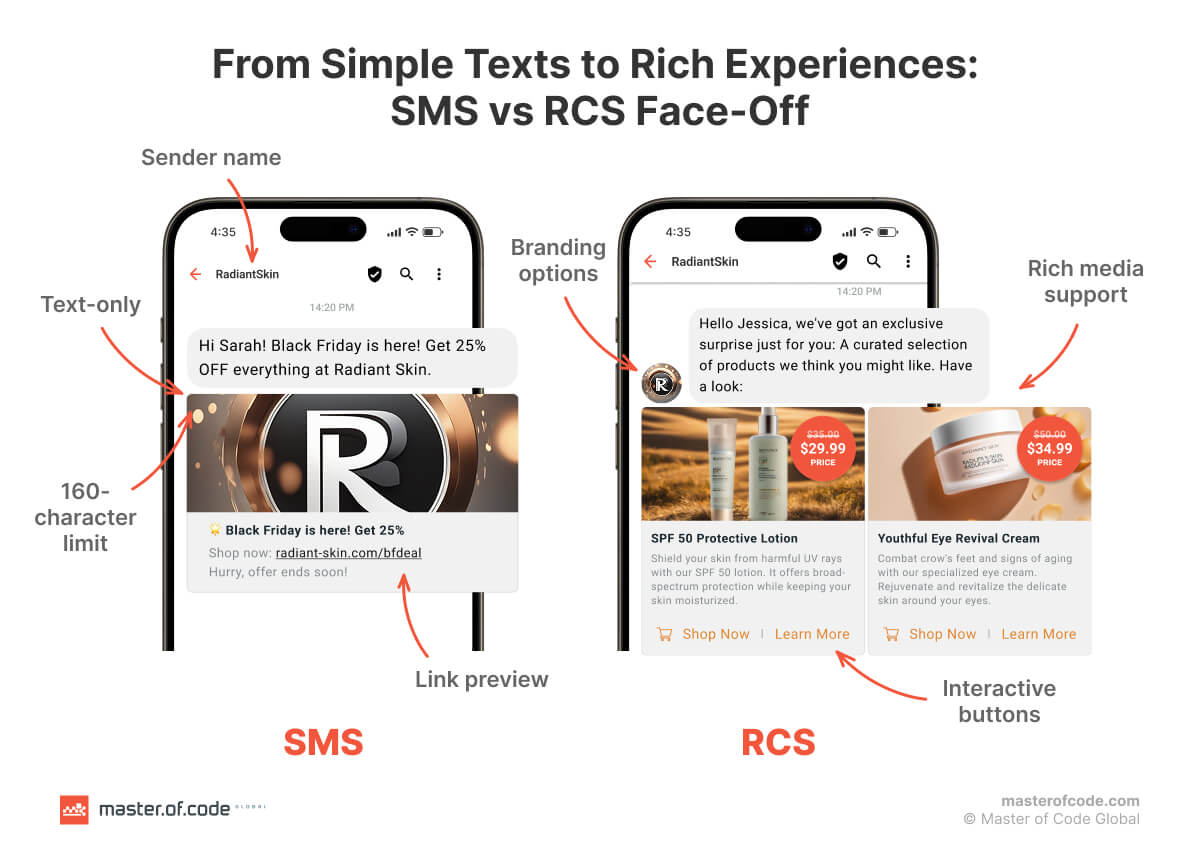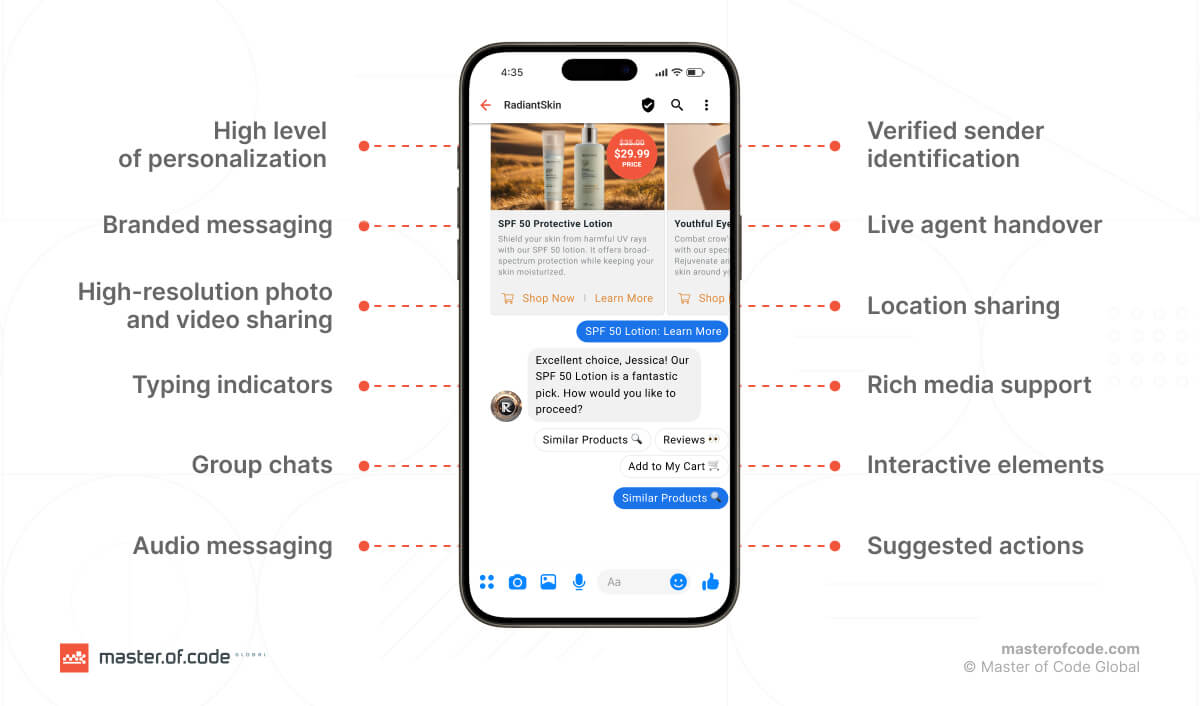Remember the last time you tried to engage a customer? Maybe it was through an SMS campaign, or perhaps you struggled to cut through the noise of overflowing email inboxes. Traditional communication methods are increasingly failing to capture customers’ attention. What if there was a way to connect with your audience in a rich, interactive, and personal way, right within their smartphones?
That’s the power of RCS messages for business. Naturally, its adoption isn’t just growing—it’s accelerating rapidly. In June 2023, it surged over 40% year-over-year, outpacing all other channels. This momentum intensified during the 2024 BFCM season, with brands witnessing a phenomenal 111% spike in usage compared to 2023. And this trend continues in 2025. Take, for example, the recent partnership between Listrak and Dooney & Bourke to launch their first marketing RCS campaign. Isn’t that mind-blowing?

Our former VP of Sales & Partnerships, Ted Franz, stated, “Rich Communication Services are the future of marketing and communications, and businesses must implement it to remain competitive.” So if you haven’t experimented with RCS chat yet, now may be the time to start.
To support companies in the early stages of their journey, we’ve compiled this insider’s guide. We’ll cut through the hype and provide practical insights to help you determine if RCS messaging is a smart investment choice, and if so, how to drive its maximum value. Here we go!
Table of Contents
What is an RCS Message?
RCS Business Messaging (RBM) is a next-generation messaging protocol for Android and Apple designed to enhance and eventually replace SMS. This technology offers a more immersive, dynamic experience compared to traditional texting, bringing features like high-quality media sharing, read receipts, typing indicators, and interactive elements directly into a user’s native app (like Android Messages). Rich Communication Services takes this a step further, allowing businesses to connect with clients through branded, verified exchanges that foster trust and engagement.
RCS messages come in various forms, each designed for specific purposes:
- Basic: Similar to SMS, these are text-based correspondence (up to 160 characters) ideal for branded and secure notifications or alerts. They can also include URL previews.
- Single Rich Messages: These allow for richer content, including images, buttons, cards, carousels, and longer text. They are perfect for showcasing products or promotions.
- Conversational Type: Developed for two-way interactions, such a format enables real-time conversations with customers, often integrated with chatbots for automated personalized support and recommendations. They can be brand-initiated or user-initiated.
Where is RCS Messaging Available?
Google RCS is rapidly expanding its global footprint, with 90 operator launches in 60 countries. Current supported regions include: Albania, Argentina, Brazil, Canada, Colombia, Czech Republic, France, Germany, Greece, Hungary, Italy, Malta, Mexico, New Zealand, Portugal, Romania, South Africa, Spain, Turkey, the UK, and the USA.
While RBM presents a significant leap forward in communication capabilities, understanding its strengths requires a clear comparison with existing channels. Let’s examine how it stacks up against SMS, MMS, OTT apps, and even email, revealing the tangible advantages RCS chat brings to the table.
RCS Messaging, SMS, MMS, and OTT: A Business Comparison

As we’ve seen, RCS offers a compelling alternative to traditional channels. But how does it compare in practice? Let’s explore the key differences between them to understand where RBM truly shines.
Google’s RCS services is the next evolution of SMS, enabling immersive and captivating exchanges directly within the user’s native messaging environment. It combines the universal reach of SMS with the functionality of OTT apps, which is perfect for high-impact marketing and enhanced customer engagement. For example, it can be utilized in such scenarios: a retailer sends a tailored product recommendation, a restaurant promotes a flash sale, or a healthcare provider delivers an appointment reminder.
SMS (Short Message Service) is a text-only service, limited to 160 characters, and is universally accessible on all mobile phones. Its simplicity and broad reach make it best suited for essential notifications and alerts. Due to its basic nature, it is not as ideal for marketing campaigns as RCS. SMS can be integrated in instances such as when a delivery service sends a shipping update or a bank sends a two-factor authentication code, which is not 100% secure and verified.
MMS (Multimedia Messaging Service) extends SMS by allowing content like images, videos, and audio. While more versatile, it still has limitations in interactivity, positioning it as most useful for visually driven messages and location-based information. However, without branding, some users could be wary of such communication. Examples of use cases are: a car dealership sharing a short video showcasing a new model or a clothing store sending a promotional image with a discount.
OTT (Over-the-Top) Messaging Apps offer rich media, voice/video calls, file sharing, and group chats. Popular examples include WhatsApp, Telegram, Facebook Messenger, and Signal. They are beneficial for personalized client care, building communities, and in-depth conversations. Yet, these applications have to be downloaded and updated continually. For illustration, they can be used in cases like: a brand creates a community group to share exclusive content and engage with its most loyal customers or a travel agency conducts consultations via video call.
Here is a more structured comparison of these channels:
| Feature | RCS | SMS | MMS | OTT |
|---|---|---|---|---|
| Network | Mobile networks & wifi | Cellular networks | Cellular networks | Mobile networks & wifi |
| Content | Supports rich media (images, videos, GIFs), interactive buttons, no character limit | Text-only, 160-character limit per message, no rich media or clickable links | Supports images, videos, audio, and longer text (varies by carrier) | Supports rich media, long text, interactive buttons, links, and reactions |
| Features | Typing indicators, read receipts, suggested replies, carousels, payments | Basic one-way or two-way messaging | Basic media sharing but lacks interactive elements | Typing indicators, read receipts, reactions, payments, automation |
| Accessibility | Built-in on Android, iOS 18 support | Universal | Universal | Requires app installation |
| Security | Encrypted in transit and end-to-end in some cases; verified senders | Basic; susceptible to interception or spoofing | Basic; potential security risks similar to SMS | End-to-end encryption |
| Use Cases | Marketing, customer service, promotions, transactions, personalized offers | Notifications, alerts, reminders, basic customer updates | Product showcases, visual promotions | Customer support, community engagement, personalized recommendations |
Now that we’ve explored the landscape, let’s explore specific capabilities that make Rich Communication Services so powerful for businesses.
Inside RCS Messages: Key Features and Their Impact

RBM isn’t just about richer messages; it’s about delivering real business results. These key elements demonstrate how:
- The protocol lets organizations use their brand name or logo as their verified ID, promoting trust and increasing recognition. This creates a credible presence within the messaging environment, fostering trust and decreasing the uncertainty often linked to short codes or unfamiliar numbers.
- While not universally available, end-to-end encryption provides a secure channel, protecting sensitive details and strengthening consumer confidence. It’s paramount for transactions, personal data, or confidential exchanges, reducing the risk of breaches and securing regulatory compliance.
- The channel is known for higher text limits compared to SMS. This way, companies are able to send longer, more detailed messages. The result is layered storytelling, more thorough product descriptions, and more seamless service interactions, boosting retention.
- High-resolution image and video features empower firms to showcase products, services, and promotions in visually compelling ways. A richer visual experience helps capture attention, drive conversions, and amplify brand impact.
- RCS messaging facilitates effortless and direct transfer of large files, such as documents, PDFs, and presentations. This enhances workflow by consolidating communication, cutting out the need for separate file-sharing tools, and improving coordination.
- Read receipts capability verifies message status, offering organizations actionable data analytics on client responsiveness. Businesses can exploit these metrics to optimize outreach strategies, elevate interaction levels, and evaluate campaign performance.
- Typing indicator shows when a contact is composing a response, facilitating a more real-time and interactive experience. They are particularly useful in customer support scenarios, signaling that a response is on its way and managing consumer expectations.
- With cross-platform connectivity, RCS chat ensures broader reach and a uniform user journey. It eliminates fragmentation and extends market presence.
- The protocol supports suggested answers and quick-reply buttons, making it easier for clients to respond with a single tap. Such a simplification encourages engagement and reduces friction in the process.
- Group chats are valuable for community building, better assistance, or internal team relations. Targeted groups can be used to share information, gather feedback, and foster a sense of belonging, leading to increased loyalty.
- Enhanced spam protection helps safeguard users from unwanted correspondence, creating a reliable and more trustworthy environment. This raises open rates, satisfaction, and the overall effectiveness of campaigns.
- AI-driven enhancements can further expand RCS messaging capabilities, enabling personalized recommendations, automated responses, and other intelligent features. Technology fosters quicker resolution times, brings more in-depth insights, and upgrades overall service quality.
RCS Users Engage More—Here’s Why Your Brand Needs It
RCS messages redefine business communications by making interactions more engaging, safe, user-driven, and effective. Unlike traditional SMS or email, it captures attention with rich, visually appealing materials that stand out and drive intended action. With verified sender identities and branded experiences, companies create a more trusted and frictionless channel.
At the same time, the benefits of RCS to user experience and businesses go beyond aesthetics. With personalized and interactive content, users stay engaged longer, leading to higher conversion rates. Data show that RBM campaigns achieve three to seven times higher CTR than rich SMS, while 90% of rich media messages are opened within 15 minutes.

Customers engage with rich content for up to 45 seconds, and people are 35 times more likely to review such correspondence than an email. Campaigns using this protocol see an 80% conversion level, while RCS messages deliver an 86% higher read rate than email newsletters. The ability to provide tailored promotions, real-time updates, and seamless transactions makes this technology a powerful tool for both marketing and customer support.
In addition to higher engagement, RBM provides real-time analytics, helping firms track performance and refine initiatives instantly. RCS Universal Profile ensures full compatibility across carriers and devices, while reliable fallback guarantees delivery when service isn’t available.
With adoption growing rapidly, top brands are already adopting RCS to elevate client experiences and facilitate measurable results. Let’s take a closer look at how enterprises across banking, retail, and telecom are using Rich Communication Services to upgrade their strategies.
Industry Use Cases: How RCS Messaging Powers Banking, Retail, and Telecom
Whether it’s enhancing security for banks, driving conversions for retailers, or streamlining support for telecom providers, RCS experiences are demonstrably smarter, more dynamic, and more engaging. Here’s how this powerful technology is making a real impact across industries.

Banking
RCS messaging is used to deliver interactive debt collection reminders featuring outstanding balances, due dates, and one-tap payment options within a safe, branded chat. Unlike SMS, the protocol enables two-way conversations, allowing clients to negotiate billing arrangements, request extensions, or ask for support in real-time. This improves collection success and reduces delinquency rates.
With RCS in banking, financial institutions send targeted offers, such as exclusive interest rates, loan pre-approvals, or credit card perks, tailored to customer behavior. Smart chat features let users compare plans, calculate loan payments, or apply instantly—all within the same interface.
Traditional financial education can be complex and easily overlooked. RCS messages simplify key topics—like investment strategies, mortgage alternatives, or budgeting—through engaging infographics, short videos, and dynamic Q&A elements. Consumers explore information at their own pace, leading to more informed decisions and stronger product adoption.
Retail
Retailers use RCS campaigns to deliver personalized deals and advertisements that go beyond traditional SMS. Rather than basic text, clients get engaging suggestions with vibrant high-quality creative, interactive carousels, and one-click buttons for effortless purchasing. Businesses can tailor promotions based on browsing history, past purchases, and customer preferences, making each texting highly relevant and conversion-driven.
During high-traffic occasions like Black Friday or seasonal events, RCS in retail helps brands cut through inbox clutter with immersive, time-sensitive promotions. Messages can feature countdown timers, flash sale alerts, and exclusive VIP offers, driving urgency and increasing engagement. Limited-time discounts are paired with quick-action buttons, allowing shoppers to claim deals in just one tap.
Retailers recover lost revenue by using RCS messages to remind customers about abandoned carts. Unlike generic email reminders, these exchanges include visual previews of forgotten items, restock reports, and individualized incentives to encourage checkout completion. Integrated and simplified purchase flow streamlines the process, reducing friction and boosting conversion rates.
Telecom
Billing and account management become simpler with built-in RCS, removing the need to log into external apps or portals. Users receive notifications about billing cycles, deadlines, and data utilization, along with secure options to modify their arrangements or pay directly within the interface. There is a possibility to access on-demand payment history and usage summaries, making profile control effortless and transparent.
When it comes to service optimization, RCS in telecom enables businesses to deliver personalized plan recommendations based on individual consumption patterns. Whether clients frequently exceed their data limit or travel abroad, they obtain tailored suggestions for better-suited plans, roaming add-ons, or premium features. It is an easy way to explore opportunities, compare benefits, and activate new services, all while staying within the same conversation.
Unexpected disruptions cause frustration, but with RCS message support, providers keep people notified in real-time. Instead of leaving users in the dark about outages or maintenance schedules, they provide instant updates on affected areas, estimated resolution times, and possible solutions. Moreover, individuals have the option to report difficulties right within the same system, ensuring they remain updated without contacting support agents.
These use cases demonstrate the versatility of RCS chat, but how is it performing in the real world? Let’s explore some case studies that showcase its tangible impact on businesses.
See RCS Messages in Action: Inspiring Success Stories
BankBazaar, an online financial marketplace, intended to boost customer engagement with their marketing campaigns. They used RCS to share visually rich messages promoting their app and credit score checks. This resulted in a 130% higher click-through rate compared to their previous SMS initiative.
Axis Bank‘s goal was to provide a more interactive and digitally savvy financial experience. Integrating RCS messaging, they created a self-service tool for managing inquiries and transactions related to loans, credit cards, and fixed deposits. The outcome was a 45% rise in cross-selling opportunities and over 2,000 users activating their chatbot.
Orange, a mobile carrier with a presence in France and 18 African countries, sought to increase awareness and adoption of RCS chat. They launched a multi-country chatbot during the 2019 Africa Cup of Nations, providing users with real-time scores, updates, and immersive experiences. This campaign doubled their active RCS users in Africa, tripled them in Senegal, and generated over a million messages, making it one of the top bots worldwide.
Telekom Deutschland wanted to promote a Spotify Premium trial offer to its subscribers using a more engaging channel. They partnered with Infobip to create an omnichannel strategy featuring rich media, interactive buttons, and branding elements within RCS messages. This led to significantly higher metrics in contrast to SMS, with a 26% higher open rate, 66% higher engagement, and 120% higher conversion in their second campaign.
Club Comex was also looking to maximize customer engagement and grow CTR beyond SMS results. In collaboration with Infobip, the brand implemented two campaigns: one sales-focused and another for lead nurturing. Thanks to the capabilities of RBM, they achieved 115% revenue growth and up to 10x higher click-through rates.
Casas Bahia, a major Brazilian retailer, set out to raise the adoption of their installment payment solution, “Carnê Digital.” RCS messages allowed the company to engage customers with multimedia content and user-driven interactions within the same interface. This yielded an 8% increase in orders, a 17% rise in sales income compared to other conversational channels, and a remarkable 6.2x higher ROI.
Master of Code Global also stays at the forefront of the adoption of RCS messaging. See how beauty brand Radiant Skin adopts RBM and Vertex AI to provide personalized consultations, product recommendations, and exceptional support, all within the native app. Watch the demo to learn how we helped realize this winning combination, building loyalty and driving sales.
Wrapping Up
RCS messages aren’t just an upgrade—it’s a trailblazer reinventing business interactions. By combining rich media, intuitive flow, and personalized content, the technology is recasting customer connections across industries. From uninterrupted banking experiences to interactive retail promotions and enhanced telecom assistance, it delivers higher engagement, better conversions, and positive ROI. Companies adopting RCS gain a competitive edge by creating a more dynamic, customer-friendly touchpoint that goes beyond the limitations of SMS and email.
At Master of Code Global, we specialize in RCS implementation, working with leading providers to help businesses get the most out of it. Our tailored approach ensures a hassle-free transition to this new channel, whether for marketing, customer support, or transactional communication.
If you’re considering RCS messaging but not ready for full integration, we offer an exclusive managed pilot program—a one-month A/B test to compare its performance against your current strategy. We handle everything:
- Campaign management
- Creative and design tips
- In-depth data analysis
The benefits? Minimal effort on your end, cost savings, faster time-to-market, and a risk-free way to measure RCS’ impact on your business.
Interested in testing RCS chat for your brand? Contact us today to launch your pilot and see the results firsthand.
Ready to build your own Conversational AI solution? Let’s chat!





